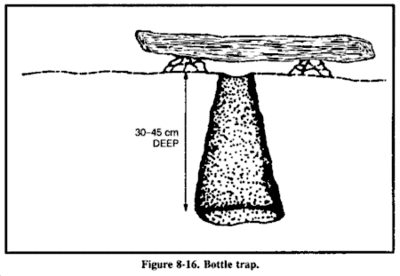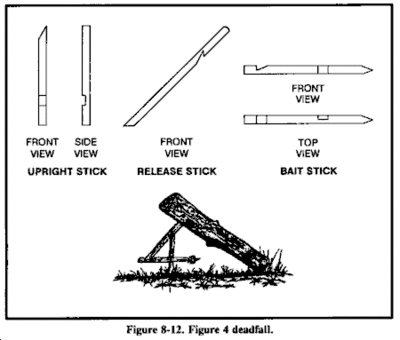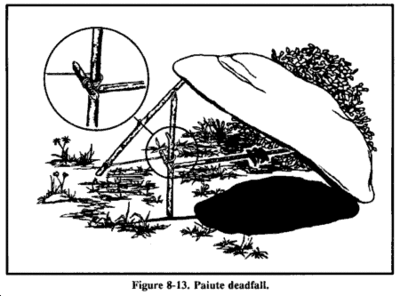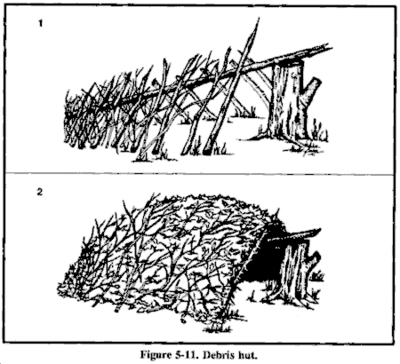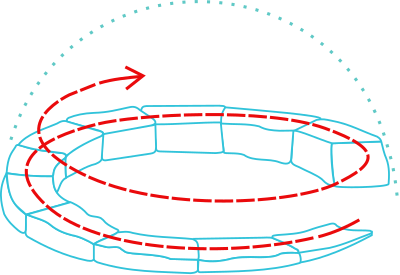Difference between revisions of "AY Honors/Wilderness Leadership - Advanced/Answer Key"
Jomegat bot (talk | contribs) (Bot: Automated import of articles *** existing text overwritten ***) |
m |
||
| Line 46: | Line 46: | ||
<!-- 3. What physical and mental preparations are necessary before a wilderness experience? --> | <!-- 3. What physical and mental preparations are necessary before a wilderness experience? --> | ||
===Physical=== <!--T:38--> | ===Physical=== <!--T:38--> | ||
| − | Physical readiness not only implies physical fitness, but also the many things that have to be done to make the trip possible. | + | Physical readiness not only implies physical fitness, but also the many things that have to be done to make the trip possible. |
*Choose a destination. | *Choose a destination. | ||
*Evaluate what sort of equipment will be needed for the ''possible'' conditions (not just the likely ones). | *Evaluate what sort of equipment will be needed for the ''possible'' conditions (not just the likely ones). | ||
| Line 54: | Line 54: | ||
*Make sure that the participants have gathered the equipment they will need. | *Make sure that the participants have gathered the equipment they will need. | ||
*Organize transportation (drop off and pick up if it is not a loop trip). | *Organize transportation (drop off and pick up if it is not a loop trip). | ||
| − | *Distribute medical release forms to all participants. | + | *Distribute medical release forms to all participants. Minors should have theirs signed by a legal guardian. The leader and alternate should have copies of these forms with them. |
*Select a menu and buy food | *Select a menu and buy food | ||
*Pack! | *Pack! | ||
| Line 64: | Line 64: | ||
*Know the rules governing the area you are going. | *Know the rules governing the area you are going. | ||
*Check the weather forecast. | *Check the weather forecast. | ||
| − | *Talk with the government officials responsible for the area where you will spend your time. | + | *Talk with the government officials responsible for the area where you will spend your time. Check in with them when you arrive and let them know your plans. Check with them again when you leave. |
| − | *Review [[ | + | *Review [[AY Honors/First Aid, Standard|First Aid]] principles |
| − | *Review [[ | + | *Review [[AY Honors/Fire Building & Camp Cookery|Fire Safety]] |
| − | *Teach your group the things you have reviewed. | + | *Teach your group the things you have reviewed. If the only person who knows first aid is injured, who will administer first aid? Everyone should know what to do. |
*Go over group safety principles. | *Go over group safety principles. | ||
*Appoint a leader and an alternate in case something happens to the leader. | *Appoint a leader and an alternate in case something happens to the leader. | ||
| Line 128: | Line 128: | ||
<noinclude><translate></noinclude> | <noinclude><translate></noinclude> | ||
<!-- 5. Demonstrate the construction and operation of two types of snares or traps. --> | <!-- 5. Demonstrate the construction and operation of two types of snares or traps. --> | ||
| − | These traps and their descriptions were taken from the ''U.S. Army Field Manual, No. 21-76, Survival''. | + | These traps and their descriptions were taken from the ''U.S. Army Field Manual, No. 21-76, Survival''. Note that for the purpose of practicing the building of these traps, the two deadfalls can be rendered harmless by replacing the heavy weight with a basket. Any animal will then be caught unharmed, allowing you to release it. |
===Bottle Trap=== <!--T:49--> | ===Bottle Trap=== <!--T:49--> | ||
[[File:Bottle trap.gif|thumb|400px|Bottle Trap]] | [[File:Bottle trap.gif|thumb|400px|Bottle Trap]] | ||
| Line 180: | Line 180: | ||
<noinclude><translate><!--T:58--> | <noinclude><translate><!--T:58--> | ||
</noinclude> | </noinclude> | ||
| − | Water travel means travelling by means of some sort of boat, be it a sailboat, motorboat, rowboat, canoe, or kayak. | + | Water travel means travelling by means of some sort of boat, be it a sailboat, motorboat, rowboat, canoe, or kayak. In all cases, it is important that every person have access to a Personal Flotation Device (PFD), also known as a life jacket. See the answers to the following honors for more information: |
| − | *[[ | + | * [[AY Honors/Sailing|Sailing]] |
| − | *[[ | + | * [[AY Honors/Power Boating|Power Boating]] |
| − | *[[ | + | * [[AY Honors/Rowing|Rowing]] |
| − | *[[ | + | * [[AY Honors/Canoeing|Canoeing]] |
| − | *[[ | + | * [[AY Honors/Kayaking|Kayaking]] |
<!--T:59--> | <!--T:59--> | ||
| Line 195: | Line 195: | ||
</noinclude> | </noinclude> | ||
<!-- 7. Understand the principles of developing a faith in divine leadership as outlined in Psalms 91. --> | <!-- 7. Understand the principles of developing a faith in divine leadership as outlined in Psalms 91. --> | ||
| − | The wilderness, though filled with beauty, is an inherently dangerous place. | + | The wilderness, though filled with beauty, is an inherently dangerous place. The dangers presented by the wilderness come in many forms, including wild animals, weather, flash flooding, injuries, falls from high places, falling trees, etc. This list could extend for many pages. Compounding these dangers is the fact that any incidents which require medical attention will have to be dealt with long before a victim can be transported to a hospital. So while it is important that one's skills match the situations likely to be encountered, it is also important that the leader stay in touch with The Almighty. |
<!--T:16--> | <!--T:16--> | ||
| − | Get in the habit of communing with Him on a regular basis. | + | Get in the habit of communing with Him on a regular basis. Consult Him on all major decisions. But most of all, understand that He will be with you as you face any danger. ''For he will command his angels concerning you to guard you in all your ways.'' - Psalm 91:11, NIV. |
<!--T:61--> | <!--T:61--> | ||
| Line 207: | Line 207: | ||
</noinclude> | </noinclude> | ||
<!-- 8. Understand what steps should be taken for the survival of the wilderness. --> | <!-- 8. Understand what steps should be taken for the survival of the wilderness. --> | ||
| − | The survival of the wilderness is threatened by man. | + | The survival of the wilderness is threatened by man. Our continual overuse of resources drives people to clear forests at a rate much faster than they can regrow. The best protection the wilderness has is that we change our lifestyles so that they are ''sustainable''. Try walking or riding a bike instead of jumping mindlessly into the car. Buy a fuel-efficient car instead of a gas-guzzler. Learn how to repair things instead of throwing them away and replacing them (this is a lot easier when you buy quality items rather than "disposable" ones). Pay attention to how the things you consume are made. Remember that it takes more energy to feed corn to beef cattle than it does for you to eat the corn yourself. By controlling consumption, we can slow the rate at which the wilderness disappears. |
<!--T:18--> | <!--T:18--> | ||
| − | Many governments have recognized this problem and have responded by setting aside protected wilderness areas. | + | Many governments have recognized this problem and have responded by setting aside protected wilderness areas. These are the areas you are likely to enjoy when you engage in the activities outlined in this honor, so it is imperative that you do everything you can to preserve them. Wilderness lovers frequently quote two mottoes related to the preservation of the wilderness. The first is ''"Take only pictures, leave only footprints."'' The second is ''"Pack in, pack out."'' The first of these is covered sufficiently in the Camping Skills honors that lead up to this one, so we will not rehash it here. The second relates to the practice of not leaving anything in the wilderness that you brought in with you. There are many old (and out-of-date) woodcraft guides that advise burning your trash, and burying what you cannot burn. Modern practice dictates that if you had the space in your pack to bring your trash into the wilderness with you, you will also have room in your pack to bring right back out. Do not leave your trash behind. |
<!--T:63--> | <!--T:63--> | ||
| Line 218: | Line 218: | ||
<noinclude><translate><!--T:64--> | <noinclude><translate><!--T:64--> | ||
</noinclude> | </noinclude> | ||
| − | <!-- 9. Assist in instructing one honor listed in requirement 1 of the Wilderness Leadership | + | <!-- 9. Assist in instructing one honor listed in requirement 1 of the Wilderness Leadership honor. --> |
| − | * [[ | + | * [[AY Honors/Backpacking|Backpacking]] |
| − | * [[ | + | * [[AY Honors/Camping Skills I|Camping Skills I]] |
| − | * [[ | + | * [[AY Honors/Camping Skills II|Camping Skills II]] |
| − | * [[ | + | * [[AY Honors/Camping Skills III|Camping Skills III]] |
| − | * [[ | + | * [[AY Honors/Camping Skills IV|Camping Skills IV]] |
| − | * [[ | + | * [[AY Honors/Fire Building & Camp Cookery|Fire Building & Camp Cookery]] |
| − | * [[ | + | * [[AY Honors/First Aid, Standard|First Aid]] |
| − | * [[ | + | * [[AY Honors/Hiking|Hiking]] |
| − | * [[ | + | * [[AY Honors/Orienteering|Orienteering]] |
<!--T:65--> | <!--T:65--> | ||
| Line 252: | Line 252: | ||
===Snow Shelters=== <!--T:21--> | ===Snow Shelters=== <!--T:21--> | ||
[[File:Igloo spirale.svg|thumb|400px|Igloo construction]] | [[File:Igloo spirale.svg|thumb|400px|Igloo construction]] | ||
| − | Another option is to build an igloo, build a snow fort, hollow out a snow drift, or build a Quinzhee (which is made by first making a pile of snow, and then hollowing it out). | + | Another option is to build an igloo, build a snow fort, hollow out a snow drift, or build a Quinzhee (which is made by first making a pile of snow, and then hollowing it out). All of these require a considerable expenditure of energy, and it is imperative that the workers not soak their clothing with sweat while working. If you find you are sweating, remove a layer or two. |
<!--T:22--> | <!--T:22--> | ||
| Line 261: | Line 261: | ||
<!--T:24--> | <!--T:24--> | ||
| − | The snow for a quinzhee need not be of the same quality as required for an igloo. Quinzhees are not usually meant as a form of permanent shelter, while igloos can be used for seasonal and year round habitation. The construction of a quinzhee is slightly easier than the construction of an igloo, although the overall result is somewhat less sturdy and more prone to collapsing in harsh weather conditions. Quinzhees are normally constructed in times of necessity, usually as an instrument of survival, so aesthetic and long-term dwelling considerations are normally exchanged for economy of time and materials. | + | The snow for a quinzhee need not be of the same quality as required for an igloo. Quinzhees are not usually meant as a form of permanent shelter, while igloos can be used for seasonal and year round habitation. The construction of a quinzhee is slightly easier than the construction of an igloo, although the overall result is somewhat less sturdy and more prone to collapsing in harsh weather conditions. Quinzhees are normally constructed in times of necessity, usually as an instrument of survival, so aesthetic and long-term dwelling considerations are normally exchanged for economy of time and materials. |
<!--T:25--> | <!--T:25--> | ||
| − | To build a quinzhee, begin by making a large pile of snow about {{units|2 meters|6 feet}} high, and {{units|3 meters|10 feet}} in diameter. | + | To build a quinzhee, begin by making a large pile of snow about {{units|2 meters|6 feet}} high, and {{units|3 meters|10 feet}} in diameter. You can optionally start the pile with large, easily removed items, such as a couple of backpacks. This will make it easier to hollow out the pile, but if you find yourself in need of something in your pack before the pack has been freed, you will have to wait. Once the pile has been built, let it set for an hour or two. This allows the snow to undergo a process called ''sintering'' which binds the ice crystals together. Before you begin hollowing it out though, find several sticks {{units|20-30 cm|8-12 inches}} long. Break them until they are all the same length, then jam them straight into the pile until they disappear. These will help you gauge the thickness of the walls as you hollow out the center. Then, using a shovel, start removing snow. Dig a tunnel first, then enlarge it. Stop digging in an area when you find one of the gauge sticks inserted previously. The last step it to create a couple of ventilation holes. These should be small tunnels about {{units|5 cm|2 inches}} in diameter, positioned not at the top of the quinzhee, but not far from it either. |
<!--T:26--> | <!--T:26--> | ||
| − | In any of these structures, it is important to make the resting area higher than the floor. | + | In any of these structures, it is important to make the resting area higher than the floor. This is because cold air sinks, so the coldest place inside a snow shelter will be on the floor. |
{{clear}} | {{clear}} | ||
Revision as of 15:48, 25 May 2021
Skill Level
3
Year
1976
Version
01.12.2025
Approval authority
General Conference
1
For tips and instruction see Edible Wild Plants.
For tips and instruction see Outdoor Leadership.
For tips and instruction see Wilderness Leadership.
For tips and instruction see Wilderness Living.
2
In order to come close to an animal, trackers must remain undetected not only by the animal, but also by other animals that may alert it. Moving as quietly as possible, trackers will avoid stepping on dry leaves and twigs, and take great care when moving through dry grass.
If the trackers are in close proximity to the animal, it is important that they remain downwind of it, that is, in a position where the wind is blowing away from the animal in the direction of the tracker. They must never be in a position where their scent could be carried in the wind towards the animal and thereby alert it. It is also important that the animal does not have the opportunity to cross their tracks, since the lingering human scent will alert it. Most animals prefer to keep the wind in their faces when traveling so that they can scent danger ahead of them. Trackers will therefore usually be downwind from them as they approach the animals from behind. The wind direction may, however, have changed. If the wind direction is unfavorable, the trackers may have to leave the spoor (tracks and other indications of an animal's presence) to search for their quarry from the downwind side.
As the trackers get closer to the animal, they must make sure that they see it before it sees them. Some trackers maintain that an animal keeps looking back down its own trail, always on the alert for danger coming from behind. When the spoor is very fresh, trackers may have to leave the spoor so that the animal does not see them first. Animals usually rest facing downwind, so that they can see danger approaching from the downwind side, while they can smell danger coming from behind them. An animal may also double back on its spoor and circle downwind before settling down to rest. A predator following its trail will move past the resting animal on the upwind side before realizing that the animal had doubled back, and the resting animal will smell the predator in time to make its escape.
When stalking an animal, trackers use the cover of bushes, going down on their hands and knees where necessary. In long grass they go down on their stomachs pulling themselves forward with their elbows. The most important thing is not to attract attention by sudden movements. Trackers should take their time, moving slowly when the animal is not looking, and keeping still when the animal is looking in their direction. When stalking an animal, trackers must also be careful not to disturb other animals. A disturbed animal will give its alarm signal, thereby alerting all animals in the vicinity, including the animal being tracked down.
Text from The Art of Tracking: The Origin of Science, by Louis Liebenberg, with permission from the author. Taken from Wikipedia:Tracking (hunting)
3
Physical
Physical readiness not only implies physical fitness, but also the many things that have to be done to make the trip possible.
- Choose a destination.
- Evaluate what sort of equipment will be needed for the possible conditions (not just the likely ones).
- Let the participants know what equipment they will need.
- Gather the equipment you will need yourself.
- Gather the equipment needed by the group.
- Make sure that the participants have gathered the equipment they will need.
- Organize transportation (drop off and pick up if it is not a loop trip).
- Distribute medical release forms to all participants. Minors should have theirs signed by a legal guardian. The leader and alternate should have copies of these forms with them.
- Select a menu and buy food
- Pack!
Mental
Every participant must make mental preparations before leaving (not just the leader).
- Review a map of the area.
- Know where to get help if help is needed.
- Know the rules governing the area you are going.
- Check the weather forecast.
- Talk with the government officials responsible for the area where you will spend your time. Check in with them when you arrive and let them know your plans. Check with them again when you leave.
- Review First Aid principles
- Review Fire Safety
- Teach your group the things you have reviewed. If the only person who knows first aid is injured, who will administer first aid? Everyone should know what to do.
- Go over group safety principles.
- Appoint a leader and an alternate in case something happens to the leader.
- Work out any differences of opinion before departure.
- Understand the conditions that would make you turn back:
- Weather
- Injury or sickness
- Loss of equipment or supplies
4
4a
4b
4c
4d
4e
Snow Blindness
The reflection of the sun's ultraviolet rays off a snow-covered area causes this condition. The symptoms of snow blindness are a sensation of grit in the eyes, pain in and over the eyes that increases with eyeball movement, red and teary eyes, and a headache that intensifies with continued exposure to light. Prolonged exposure to these rays can result in permanent eye damage. To treat snow blindness, bandage your eyes until the symptoms disappear.
You can prevent snow blindness by wearing sunglasses. If you don't have sunglasses, improvise. Cut slits in a piece of cardboard, thin wood, tree bark, or other available material. Putting soot under your eyes will help reduce shine and glare.
Fire
Dried moss, grass, and scrub willow are other materials you can use for fuel. These are usually plentiful near streams in tundras (open, treeless plains). By bundling or twisting grasses or other scrub vegetation to form a large, solid mass, you will have a slower burning, more productive fuel.
Warm Clothing
Dress in layers and avoid cotton. Wool or synthetics are warm even when wet, but when cotton gets wet (even from sweat), it effectively conducts heat away from the body. Wear a waterproof outer layer. If you find you are beginning to sweat, remove a layer of clothing or vent it. It is common for a person carrying a heavy load or doing heavy work (such as with an ax or shovel) to sweat even on a very cold day. Keep adjusting your layers until you quit sweating, as you do not want to be wet. When the exertion comes to an end, sweat-soaked clothing will quickly chill you.
Travel
Travelling in the snow is in many ways easier than travelling over solid ground if you have the right equipment. Snow shoes will keep you from sinking into the snow making it far easier to walk. Skis will speed you along even faster. Load your equipment on a sled and pull it along behind you. In this way you can carry far more equipment (or small children) than you could with a backpack.
4f
Fire
Small fires are better than large ones as they require less fuel and make less smoke. Sit close. Less fuel means less work in gathering fuel. Review the answers in Camping Skills IV to refresh yourself on how to build a fire in wet weather.
Water
When travelling for extended periods of time in the wilderness, it is not practical to carry all the water you will need. Happily, it is not necessary to do that either if you know how to make the water that is available suitable for drinking. There are generally three ways to purify water: chemically, by boiling, or by filtering. The most reliable method of purifying water is by pumping it through a filter. Chemically treating the water is also easy and convenient until you run out of purification tablets. Boiling water requires that you stop long enough to build a fire and bring the water to a boil. Then you are faced with the problem of carrying boiling water. For these reasons, filtering is the preferred solution. Be sure to refill when water is available, and think ahead to when water may not be plentiful (such as near the summit of a large hill or mountain), and make adequate preparations.
Bear Danger
Bear danger is the risk encountered by humans while interacting with wild bears.
Although some bears are alpha predators in their own habitat, they do not, under normal circumstances, hunt and feed on animals of their own size (including humans). Therefore, the most important cases of bear attack occur when the animal is defending itself against any possible threat. For instance, bear sows can become extremely aggressive if they feel their cubs are threatened. Any solitary bear is also likely to become agitated if surprised or cornered by a threat maker, especially while eating.
- Dealing with bear encounters
Before backpackers are allowed to enter an area with bears, they may be required to watch a video that teaches how to avoid encountering or agitating bears. Experts emphasize keeping your distance and making noise to avoid startling a bear as the best ways to avoid a bear attack. If a bear does become confrontational, the usual advice is to raise the arms above the head so as to appear larger, and to yell at the bear. Running away can activate the bear's hunting instincts and lead to it perceiving the human as prey. If a bear does charge, persons are advised to hold their ground, as most bear charges are bluffs. Finally, if a bear does attack, the usual advice is to curl into a fetal position so as to shield vital organs and appear non-threatening. If this is not effective in stopping the attack, the only option left is to fight the bear in any way you can. The ideal place to punch a bear is the snout or eyes. This advice applies to omnivores such as brown and black bears; the best way to avoid being attacked by the completely carnivorous polar bear is not to enter any area where polar bears live, or at least remain inside a hard-shell vehicle or building.
- Food storage and garbage disposal
Bears have an excellent sense of smell, and are attracted to human and pet foods as well as refuse. Improper storage of these items can allow bears to eat human food and become dependent on it, increasing the probability of encounters with humans. Most brown and black bear encounters in human-populated areas involve so-called "trouble bears", usually young males who have just left their mothers and do not yet have a territory of their own. If they wander close to human settlements, the smells of cooking and garbage can cause them to ignore their usual instinct to avoid humans. Many parks and persons in areas with bears utilize bear-resistant garbage cans and dumpsters for this reason, and many areas have laws prohibiting the feeding of bears, even if unintentional. Campers can access bear-proof containers from many parks to store their food and trash. The containers are then buried or strung on a rope between two tall trees, out of bears' reach. They are also instructed to put their containers, campfire, and tenting 90 meters ![]() away from each other, forming a triangle.
away from each other, forming a triangle.
5
These traps and their descriptions were taken from the U.S. Army Field Manual, No. 21-76, Survival. Note that for the purpose of practicing the building of these traps, the two deadfalls can be rendered harmless by replacing the heavy weight with a basket. Any animal will then be caught unharmed, allowing you to release it.
Bottle Trap
A bottle trap is a simple trap for mice and voles (Figure 8-16). Dig a hole 30 to 45 centimeters deep that is wider at the bottom than at the top. Make the top of the hole as small as possible. Place a piece of bark or wood over the hole with small stones under it to hold it up 2.5 to 5 centimeters off the ground. Mice or voles will hide under the cover to escape danger and fall into the hole. They cannot climb out because of the wall's backward slope. Use caution when checking this trap; it is an excellent hiding place for snakes.
Figure 4 Deadfall
The figure 4 is a trigger used to drop a weight onto a prey and crush it (Figure 8-12). The type of weight used may vary, but it should be heavy enough to kill or incapacitate the prey immediately. Construct the figure 4 using three notched sticks. These notches hold the sticks together in a figure 4 pattern when under tension. Practice making this trigger before-hand; it requires close tolerances and precise angles in its construction.
Paiute Deadfall
The Paiute deadfall is similar to the figure 4 but uses a piece of cordage and a catch stick (Figure 8-13). It has the advantage of being easier to set than the figure 4. Tie one end of a piece of cordage to the lower end of the diagonal stick. Tie the other end of the cordage to another stick about 5 centimeters long. This 5-centimeter stick is the catch stick. Bring the cord halfway around the vertical stick with the catch stick at a 90-degree angle. Place the bait stick with one end against the drop weight, or a peg driven into the ground, and the other against the catch stick. When a prey disturbs the bait stick, it falls free, releasing the catch stick. As the diagonal stick flies up, the weight falls, crushing the prey.
6
6a
When travelling over glaciers, crevasses pose a grave danger. These giant cracks in the ice are not always visible as snow can be blown and freeze over the top to make a snowbridge. At times snowbridges can be as thin as a few inches. Climbers use a system of ropes to protect themselves from such hazards. Basic gear for glacier travel includes crampons and ice axes. Teams of two to five climbers tie into a rope equally spaced. If a climber begins to fall the other members of the team perform a self-arrest to stop the fall. The other members of the team enact a crevasse rescue to pull the fallen climber from the crevasse.
6b
Dangers in mountaineering are sometimes divided into two categories: objective hazards that exist without regard to the climber's presence, like rockfall, avalanches and inclement weather, and subjective hazards that relate only to factors introduced by the climber. Equipment failure and falls due to inattention, fatigue or inadequate technique are examples of subjective hazard. A route continually swept by avalanches and storms is said to have a high level of objective danger, whereas a technically far more difficult route that is relatively safe from these dangers may be regarded as objectively safer.
In all, mountaineers must concern themselves with dangers: falling rocks, falling ice, snow-avalanches, the climber falling, falls from ice slopes, falls down snow slopes, falls into crevasses and the dangers from altitude and weather. To select and follow a route using one's skills and experience to mitigate these dangers is to exercise the climber's craft.
6c
Compacted snow conditions allow one to progress on foot. Frequently crampons are required to travel efficiently over snow and ice. Crampons have 8-14 spikes and are attached to a mountaineer's boots. They are used on hard snow (neve) and ice to provide additional traction and allow very steep ascents and descents. Varieties range from lightweight aluminum models intended for walking on snow covered glaciers, to aggressive steel models intended for vertical and overhanging ice and rock. Snowshoes can be used to walk through deep snow. Skis can be used everywhere snowshoes can and also in steeper, more alpine landscapes, although it takes considerable practice to develop strong skills for difficult terrain.
6d
Water travel means travelling by means of some sort of boat, be it a sailboat, motorboat, rowboat, canoe, or kayak. In all cases, it is important that every person have access to a Personal Flotation Device (PFD), also known as a life jacket. See the answers to the following honors for more information:
7
The wilderness, though filled with beauty, is an inherently dangerous place. The dangers presented by the wilderness come in many forms, including wild animals, weather, flash flooding, injuries, falls from high places, falling trees, etc. This list could extend for many pages. Compounding these dangers is the fact that any incidents which require medical attention will have to be dealt with long before a victim can be transported to a hospital. So while it is important that one's skills match the situations likely to be encountered, it is also important that the leader stay in touch with The Almighty.
Get in the habit of communing with Him on a regular basis. Consult Him on all major decisions. But most of all, understand that He will be with you as you face any danger. For he will command his angels concerning you to guard you in all your ways. - Psalm 91:11, NIV.
8
The survival of the wilderness is threatened by man. Our continual overuse of resources drives people to clear forests at a rate much faster than they can regrow. The best protection the wilderness has is that we change our lifestyles so that they are sustainable. Try walking or riding a bike instead of jumping mindlessly into the car. Buy a fuel-efficient car instead of a gas-guzzler. Learn how to repair things instead of throwing them away and replacing them (this is a lot easier when you buy quality items rather than "disposable" ones). Pay attention to how the things you consume are made. Remember that it takes more energy to feed corn to beef cattle than it does for you to eat the corn yourself. By controlling consumption, we can slow the rate at which the wilderness disappears.
Many governments have recognized this problem and have responded by setting aside protected wilderness areas. These are the areas you are likely to enjoy when you engage in the activities outlined in this honor, so it is imperative that you do everything you can to preserve them. Wilderness lovers frequently quote two mottoes related to the preservation of the wilderness. The first is "Take only pictures, leave only footprints." The second is "Pack in, pack out." The first of these is covered sufficiently in the Camping Skills honors that lead up to this one, so we will not rehash it here. The second relates to the practice of not leaving anything in the wilderness that you brought in with you. There are many old (and out-of-date) woodcraft guides that advise burning your trash, and burying what you cannot burn. Modern practice dictates that if you had the space in your pack to bring your trash into the wilderness with you, you will also have room in your pack to bring right back out. Do not leave your trash behind.
9
- Backpacking
- Camping Skills I
- Camping Skills II
- Camping Skills III
- Camping Skills IV
- Fire Building & Camp Cookery
- First Aid
- Hiking
- Orienteering
10
Debris Hut
These instructions for making a debris hut were taken from U.S. Army Field Manual, No. 21-76, Survival.
For warmth and ease of construction, this shelter is one of the best. When shelter is essential to survival, build this shelter.
To make a debris hut:
- Build it by making a tripod with two short stakes and a long ridgepole or by placing one end of a long ridgepole on top of a sturdy base.
- Secure the ridgepole (pole running the length of the shelter) using the tripod method or by anchoring it to a tree at about waist height.
- Prop large sticks along both sides of the ridgepole to create a wedge-shaped ribbing effect. Ensure the ribbing is wide enough to accommodate your body and steep enough to shed moisture.
- Place finer sticks and brush crosswise on the ribbing. These form a latticework that will keep the insulating material (grass, pine needles, leaves) from falling through the ribbing into the sleeping area.
- Add light, dry, if possible, soft debris over the ribbing until the insulating material is at least 1 meter thick--the thicker the better.
- Place a 30-centimeter layer of insulating material inside the shelter.
- At the entrance, pile insulating material that you can drag to you once inside the shelter to close the entrance or build a door.
- As a final step in constructing this shelter, add shingling material or branches on top of the debris layer to prevent the insulating material from blowing away in a storm.
Snow Shelters
Another option is to build an igloo, build a snow fort, hollow out a snow drift, or build a Quinzhee (which is made by first making a pile of snow, and then hollowing it out). All of these require a considerable expenditure of energy, and it is imperative that the workers not soak their clothing with sweat while working. If you find you are sweating, remove a layer or two.
When referring to a snowhouse, igloos are shelters constructed from blocks of snow, generally in the form of a dome. Although igloos are usually associated with all Inuit, they were predominantly constructed by people of Canada's Central Arctic and Greenland's Thule area. Other Inuit people tended to use snow to insulate their houses which consisted of whalebone and hides. Snow was used because the air pockets trapped in it make it an insulator. On the outside, temperatures may be as low as −45 °C (−49.0 °F), but on the inside the temperature may range from −7 °C (19 °F) to 16 °C (61 °F) when warmed by body heat alone.
The snow for a quinzhee need not be of the same quality as required for an igloo. Quinzhees are not usually meant as a form of permanent shelter, while igloos can be used for seasonal and year round habitation. The construction of a quinzhee is slightly easier than the construction of an igloo, although the overall result is somewhat less sturdy and more prone to collapsing in harsh weather conditions. Quinzhees are normally constructed in times of necessity, usually as an instrument of survival, so aesthetic and long-term dwelling considerations are normally exchanged for economy of time and materials.
To build a quinzhee, begin by making a large pile of snow about 2 meters![]() high, and 3 meters
high, and 3 meters![]() in diameter. You can optionally start the pile with large, easily removed items, such as a couple of backpacks. This will make it easier to hollow out the pile, but if you find yourself in need of something in your pack before the pack has been freed, you will have to wait. Once the pile has been built, let it set for an hour or two. This allows the snow to undergo a process called sintering which binds the ice crystals together. Before you begin hollowing it out though, find several sticks 20-30 cm
in diameter. You can optionally start the pile with large, easily removed items, such as a couple of backpacks. This will make it easier to hollow out the pile, but if you find yourself in need of something in your pack before the pack has been freed, you will have to wait. Once the pile has been built, let it set for an hour or two. This allows the snow to undergo a process called sintering which binds the ice crystals together. Before you begin hollowing it out though, find several sticks 20-30 cm![]() long. Break them until they are all the same length, then jam them straight into the pile until they disappear. These will help you gauge the thickness of the walls as you hollow out the center. Then, using a shovel, start removing snow. Dig a tunnel first, then enlarge it. Stop digging in an area when you find one of the gauge sticks inserted previously. The last step it to create a couple of ventilation holes. These should be small tunnels about 5 cm
long. Break them until they are all the same length, then jam them straight into the pile until they disappear. These will help you gauge the thickness of the walls as you hollow out the center. Then, using a shovel, start removing snow. Dig a tunnel first, then enlarge it. Stop digging in an area when you find one of the gauge sticks inserted previously. The last step it to create a couple of ventilation holes. These should be small tunnels about 5 cm![]() in diameter, positioned not at the top of the quinzhee, but not far from it either.
in diameter, positioned not at the top of the quinzhee, but not far from it either.
In any of these structures, it is important to make the resting area higher than the floor. This is because cold air sinks, so the coldest place inside a snow shelter will be on the floor.
11
References
- Pages using DynamicPageList3 parser function
- AY Honors/Prerequisite/Edible Wild Plants
- AY Honors/See Also/Edible Wild Plants
- AY Honors/Prerequisite/Outdoor Leadership
- AY Honors/See Also/Outdoor Leadership
- AY Honors/Prerequisite/Wilderness Leadership
- AY Honors/See Also/Wilderness Leadership
- AY Honors/Prerequisite/Wilderness Living
- AY Honors/See Also/Wilderness Living
- Missing Localization/All/Wilderness Leadership Advanced AY Honor.png/en


